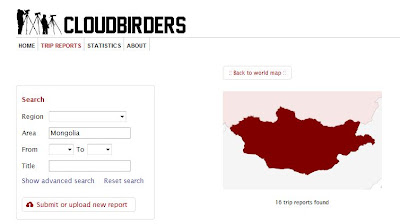Birding in Ikh Nart Nature Reserve,
Dornogobi province, 13–14 March
text & photos © Tsolmonjav PUREVSUREN
Long-tailed Tit
During these 2 days in March 2013 when I was in Ikh Nart it was warm and a little bit windy. After I got up in the morning of March 13th I spotted a Great Spotted Woodpecker near the camp.
Little Owl
Long-tailed Rosefinch, female
Long-tailed Rosefinch, young male
Around 9am when we were driving to check the Eurasian Black Vulture nests we encountered 4 Daurian Partridges near the road.
Daurian Partridge
At 1:30pm when we were having a lunch a Saker Falcon was flying over us. After we are back to the camp I walked down to the Burgas (willow) Valley where research camp is located with a colleague from Denver Zoo. We saw several groups of Argali Sheep Ovis ammon and Siberian Ibex Capra sibirica. A flock of Red-billed Choughs Pyrrhocorax pyrrhocorax were flying and some of them were sitting top of the rocks.
Red-billed Choughs
In the morning of March 14th I walked down to the valley again. This time I was be able to see more species such as Eurasian Bullfinch, Lesser Spotted Woodpecker, Long-tailed Tit, Meadow Bunting, Great Tit, Willow Tit and Long-tailed Rosefinch etc.
Eurasian Bullfinch, male.
Eurasian Bullfinch, female.
Lesser Spotted Woodpecker, male.
Lesser Spotted Woodpecker, female
After that we started to continue checking the vulture nests to the north from the camp. After we passed the local herder family I spotted a couple of Güldenstädt’s Redstart Phoenicurus erythrogastrus. This was the first migratory bird I saw in 2013.
Güldenstädt’s Redstart
Meadow Bunting, female
Pine Bunting
Siberian Accentor
Around 12 o’clock we were driving in Khanan (wall) Valley and stopped to check some vulture nest. While others checking nest I walked to the trees to take the Great Spotted Woodpecker’s photo. I took several photos and I kept chasing it to take better photo.
Great Spotted Woodpecker
All the sudden several Long-eared Owls Asio otus flew from the trees. After I tried to take some photos of them we found a lot of pellets on the ground. It seemed that they had been staying around there during the winter.
Long-eared Owl
Long-eared Owl
Species list
Eurasian Black Vulture Aegypius monachus
Saker Falcon Falco cherrug - 1
Common Kestrel Falco tinnunculus - 2
Daurian Partridge Perdix dauurica - 6
Pallas’s Sandgrouse Syrrhaptes paradoxus - 5
Long-eared Owl Asio otus - 10
Little Owl Athene noctua - 2
Great Spotted Woodpecker Dendrocopos major - 3
Lesser Spotted Woodpecker Dendrocopos minor - 4
Common Raven Corvus corax
Red-billed Chough Pyrrhocorax pyrrhocorax - 50
Güldenstädt’s Redstart Phoenicurus erythrogastrus - 4
Wood Nuthatch Sitta europaea - 2
Siberian Accentor Prunella montanella - 4
Great Tit Parus major - 1
Willow Tit Parus montanus - 4
Rock Sparrow Petronia petronia - 2
Eurasian Tree Sparrow Passer montanus
Horned Lark Eremophila alpestris
Long-tailed Tit Aegithalos caudatus - 5
Eurasian Bullfinch Pyrrhula pyrrhula - 7
Long-tailed Rosefinch Uragus sibiricus - 3
Pine Bunting Emberiza leucocephalos - 6
Meadow Bunting Emberiza cioides - 4



































